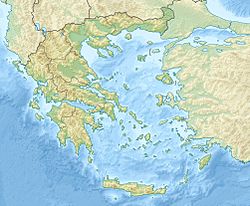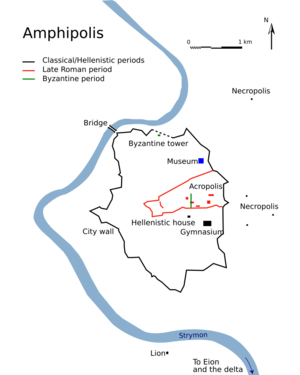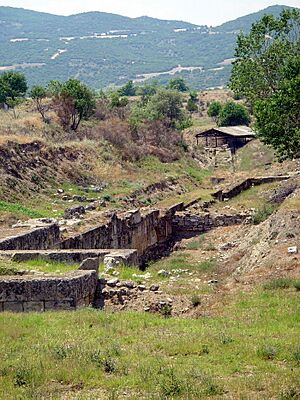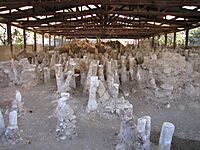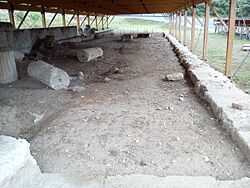Amphipolis facts for kids
|
Ἀμφίπολις
Αμφίπολη |
|

Amphipolis sites
|
|
| Location | Macedonia, Greece |
|---|---|
| Coordinates | 40°49′6″N 23°50′24″E / 40.81833°N 23.84000°E |
| Type | Settlement |
Amphipolis (Greek: Αμφίπολη, romanized: Amfipoli; Ancient Greek: Ἀμφίπολις, romanized: Amphipolis) was an important ancient Greek city, called a polis. Later, it became a Roman city. You can still see many large remains of this old city today.
Amphipolis gave its name to the modern town of Amfipoli. This town is in the Serres area of northern Greece.
This city was first a colony of ancient Athenians. It was the site of a big battle between the Spartans and Athenians in 422 BC.
Later, Alexander the Great got ready for his campaigns here. These led to his invasion of Asia in 335 BC. Three of Alexander's best admirals, Nearchus, Androsthenes, and Laomedon, lived in Amphipolis.
After Alexander's death, his wife Roxana and their son Alexander IV were held here. They died in Amphipolis in 311 BC.
Digs in and around the city have found important buildings, old walls, and tombs. The things found are shown at the Amphipolis archaeological museum.
Near the city, at the huge Kasta burial mound, an ancient Macedonian tomb was recently found. The Lion of Amphipolis monument nearby is a popular place for visitors. Amphipolis was located in the Edonis region.
History of Amphipolis
How Amphipolis Started
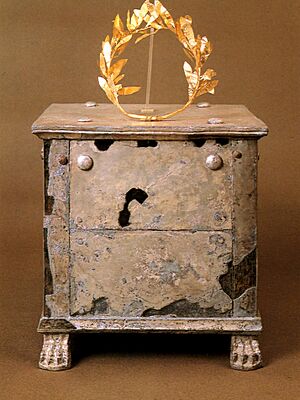
In the 400s BC, Athens wanted to control Thrace. This area was very important because it had valuable materials. These included gold and silver from the Pangaion hills. It also had thick forests that provided wood for building ships.
Sea routes through Thrace were also vital for Athens to get grain from Scythia.
The first attempt to set up a colony was in 497 BC. It was made by Histiaeus from Miletus, but it failed. After the Persians were defeated in 490 BC, the Athenian general Kimon took over Eion in 476 BC. He turned it into a military base and trading port.
Athens tried to start a colony at Ennea-Hodoi (meaning ‘Nine Ways’) in 465 BC. But the first ten thousand settlers were killed by the Thracians. A second try happened in 437 BC at the same spot. This time, under general Hagnon, it was successful.
The city and its first strong walls, 7.5 km long, were built around this time. The new Athenian colony quickly grew large and wealthy.
The new settlement was named Amphipolis. This name means "around the city." There is a lot of discussion about why it was called this. Some say it's because the Strymon River flows "around the city" on two sides. Others think it's because many people lived "around the city." A more likely idea is that the name shows it was near a narrow strip of land, like an isthmus.
Amphipolis quickly became Athens' main base in Thrace. Because of this, it was a key target for their enemies, the Spartans. In 424 BC, during the Peloponnesian War, the Spartan general Brasidas captured Amphipolis.
Two years later, in 422 BC, a new Athenian army led by general Cleon tried to take it back. This led to the Battle of Amphipolis. Both Cleon and Brasidas died in this battle. Brasidas lived just long enough to hear that the Athenians were defeated. He was buried in Amphipolis with great honor. From then on, he was seen as the city's founder. Yearly games and sacrifices were held for him.
The Athenian people were a small group in the city. So, Amphipolis stayed an independent city and an ally of Athens. It was not just a colony or part of the Athens-led Delian League. It then became a rich and diverse city.
Amphipolis Under Macedonian Rule
The city stayed independent until King Philip II took over in 357 BC. Philip succeeded where the Athenians had failed. He conquered Amphipolis. This removed the obstacle that Amphipolis presented to Macedonian control over Thrace.
The city was not immediately made part of the Macedonian kingdom. For a while, it kept its own rules and some freedom. However, Philip sent Macedonian governors to Amphipolis. In many ways, the city became "Macedonian." The names, calendar, and money were all changed to Macedonian ones.
During the time of Alexander the Great, Amphipolis was an important naval base. It was the birthplace of three famous Macedonian admirals: Nearchus, Androsthenes, and Laomedon. The famous Lion of Amphipolis likely marks their burial place.
The city's importance at this time is clear from Alexander the Great's decision. He chose Amphipolis as one of six cities where large, fancy temples would be built. These temples cost a lot of money.
Alexander prepared for his campaigns against Thrace here in 335 BC. His army and fleet gathered near the port before he invaded Asia. The port was also used as a naval base during his campaigns in Asia.
After Alexander's death, his wife Roxana and their young son Alexander IV were sent away by Cassander. They were later killed here.
Throughout Macedonian rule, Amphipolis was a strong fortress. It was very important for strategy and trade. Amphipolis became a main stop on the Macedonian royal road. Later, it was on the Via Egnatia, a major Roman road across the southern Balkans.
From this time, you can still see the walls of the lower town. Also, a gymnasium and some well-preserved paintings from a rich house remain. We don't know much about the city's layout. But we know a lot about its rules and systems. This is thanks to many written records. These include a military order from Philip V and a law about young men's training from the gymnasium.
When the Romans Took Over
After Rome finally defeated Macedonia in 168 BC, Amphipolis became a capital. It was the capital of one of four small republics. These were created by the Romans from the kingdom that followed Alexander's empire. These republics slowly became part of the Roman state, and later, a Roman province.
According to the Acts of the Apostles, the apostles Paul and Silas passed through Amphipolis. This was in the early 50s AD. They were on their journey between Philippi and Thessalonica. Here, they spoke to the Greeks.
In the 1st century BC, the city was badly damaged. This happened during a Thracian revolt against Roman rule.
Amphipolis Comes Back to Life (Late Antiquity)
During the time of Late Antiquity, Amphipolis became richer. This is shown by the many Christian churches that were built. However, these churches were built in a small part of the town. This area was protected by the walls of the acropolis. This suggests that the large old city walls could no longer be defended. It also means that the city's population had become much smaller.
Still, the number, size, and quality of the churches built between the 400s and 500s AD are impressive. Four large churches, called basilicas, have been dug up. They had rich mosaic floors and fancy stone carvings. There was also a church with a hexagonal shape.
It's hard to know why such a small town spent so much on buildings. One idea is that rich people in the late Roman period wanted to spend money on local improvements. This was used by the local church to its benefit. This led to a big improvement of the city center. Amphipolis was also a diocese under the main church of Thessalonica. The Bishop of Amphipolis is first mentioned in 533 AD.
The City's Final Decline
The Slavic invasions in the late 500s AD slowly affected Amphipolis. This led to the city's decline. During this time, its people moved to the area around the acropolis. The walls were kept up using materials taken from monuments in the lower city. The large, unused water tanks of the upper city were used for small houses and workshops.
Around the mid-600s, the city's inhabited area got even smaller. Then, the city's defenses were made stronger. A new wall with five-sided towers was built. This wall cut through the middle of the remaining buildings. The acropolis, the Roman baths, and the main church were all crossed by this wall.
The city was probably left empty in the 700s. The last bishop was recorded in 787 AD. Its people likely moved to the nearby site of ancient Eion. This was Amphipolis's port. It had been rebuilt and made stronger in the Byzantine period. It was called “Chrysopolis”. This small port continued to be somewhat successful. But it was later abandoned during the Ottoman period.
The last sign of activity in the Amphipolis area was in 1367. A strong tower was built to the north. This was to protect land given to a monastery on Mount Athos.
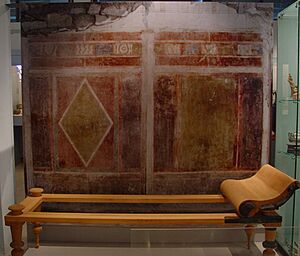
Archaeology in Amphipolis
Many travelers and archaeologists found and described the site in the 1800s. But real digs did not start until after World War II. The Greek Archaeological Society dug there in 1972 and 1985. They found a burial ground, the city wall, churches, and the acropolis. More digs have since found the river bridge, the gymnasium, Greek and Roman houses, and many tombs.
Parts of the lion monument and tombs were found during World War I. Bulgarian and British soldiers found them while digging trenches. In 1934, M. Feyel led a study of writings at the site. He found more parts of the lion monument.
A silver box with the burned remains of Brasidas and a gold crown were found in a tomb. This tomb was in an important spot under the Agora, the city's marketplace.
The Tomb of Amphipolis
In 2012, Greek archaeologists found a large tomb inside the Kasta Hill. This is the biggest burial mound in Greece, northeast of Amphipolis. The huge size and quality of the mound show that important people were buried there. Its age and the city's links to Alexander the Great suggest important people were inside. The wall around the mound is 497 meters long. It is made of limestone covered with marble.
The tomb has three rooms separated by walls. There are two sphinxes just outside the tomb's entrance. Two columns supporting the roof in the first part look like Caryatids. These are statues of women used as columns, in the style of the 300s BC.
The dig found a pebble mosaic right behind the Caryatids. It was in front of the marble door leading to the third room. The mosaic shows Persephone being taken by Hades. But the people shown are thought to be Philip and Olympias of Macedon. Hades' chariot is pulled by two white horses. Hermes leads them to the underworld. This mosaic proves the tomb is Macedonian.
The head of one of the sphinxes was found inside the tomb, behind a broken door. This shows that people, likely in ancient times, had entered the tomb.
Pieces of bones from 5 people were found in the stone tomb. The most complete bones are from a woman over 60 years old. Dr. Katerina Peristeri, the lead archaeologist, dates the tomb to the late 300s BC. This is the time after Alexander the Great died (323 BC). One idea is that the tomb was built for Alexander the Great's mother, Olympias.
The tomb is planned to be fully restored by 2023. Building materials that were later used by the Romans elsewhere will be put back in their original places.
The City Walls
The original walls were 7.5 km long. You can generally see them, especially the northern part. This section is still 7.5 meters high. Five gates are still preserved. The gate in front of the wooden bridge is especially notable.
In early Christian times, another inner wall was built around the acropolis.
The Ancient Wooden Bridge of Amphipolis
The ancient bridge that crossed the Strymon River was very important. It was mentioned by the historian Thucydides. It controlled travel between Macedonia and Thrace. It was also key for trade and the economy. Because of its importance, it was built into the city walls.
This bridge was found in 1977. It is a unique discovery for ancient Greece. Hundreds of wooden piles from the bridge have been dated. They show the bridge was used for a very long time. Some piles date from 760 BC, and others were used until about 1800 AD.
The Gymnasium
This was a major public building. It was used for the military and sports training of young people. It also provided artistic and intellectual education. It was built in the 300s BC.
The gymnasium included a palaestra. This was a rectangular court with columns around it. It had rooms next to it for many sports activities. The covered walkway, or xystos, was for indoor training in bad weather. It was a long porch, 75 meters long and 7 meters wide. This allowed 6 runners to race at the same time.
There was also an outdoor track, called paradromida. This was for training in good weather. A system of tanks provided water.
During the Macedonian era, it became a very important place.
A stone slab with the rules of the gymnasium was found in the north wing. It explained the duties and powers of the master and the education of the athletes.
After it was destroyed in the 1st century BC during the Thracian rebellion, it was rebuilt. This happened in Augustus's time in the 1st century AD, along with the rest of the city.
Famous People from Amphipolis
- Demetrius of Amphipolis, a student of Plato
- Zoilus (400–320 BC), a writer and philosopher
- Pamphilus (painter), head of a famous art school and teacher of Apelles
- Aetion, a sculptor
- Philippus of Amphipolis, a historian
- Nearchus, an admiral for Alexander the Great
- Erigyius, a general for Alexander the Great
- Damasias of Amphipolis (320 BC), won the Stadion race at the Olympics
- Hermagoras of Amphipolis (around 225 BC), a Stoic philosopher
- Apollodorus of Amphipolis, a military governor appointed by Alexander the Great
- Xena - In the TV show Xena Warrior Princess, Amphipolis is the main character's home village.
See also
- Archaeological Museum of Amphipolis
- List of ancient Greek cities


